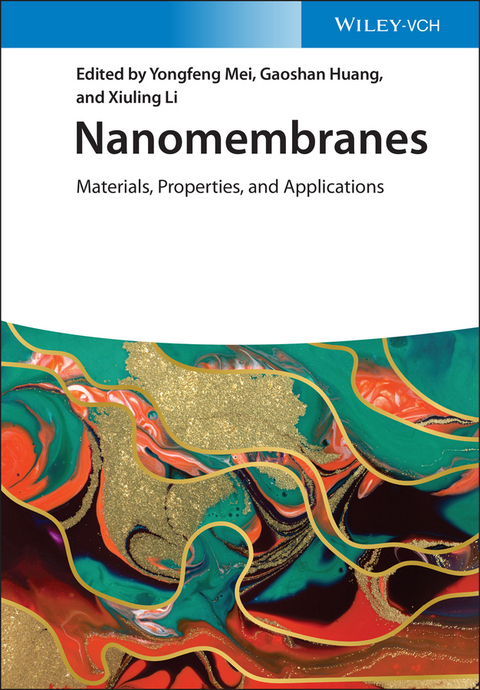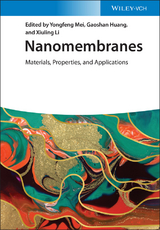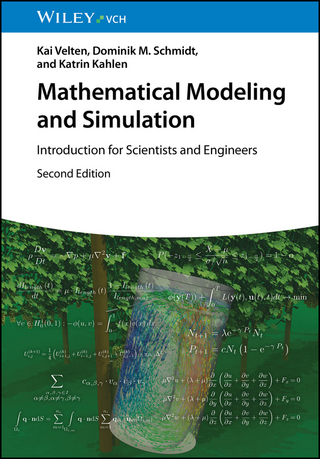Nanomembranes
Wiley-VCH (Verlag)
978-3-527-34446-8 (ISBN)
Yongfeng Mei received his BS and MS in physics from Nanjing University and PhD in materials physics from City University of Hong Kong. He is a professor in materials physics and chemistry and associated department head in the Department of Materials Science at Fudan University (China). Before that, he worked as a post-doctoral researcher in the Max Planck Institute for Solid State Research (Germany) and then led a research group in the Leibniz Institute for Solid State and Materials Research Dresden (Germany) as a staff scientist. His research interest focuses on the materials development in micro/nanorobotics, flexible electronics/optoelectronics and nanophotonics. He has published more than 200 peer-reviewed journal papers. He also serves Editorial Advisory Board of e.g. Applied Physics Letters, Chemistry of Materials, Progress in Natural Science: Materials International and Nanotechnology. Gaoshan Huang received his PhD in condensed matter physics at Nanjing University, China, in 2007. After graduation, he worked in IFW Dresden, Germany, as a guest scientist. Then he moved to IMRE, Singapore, as a research engineer. In 2010, he joined the Department of Materials Science, Fudan University, China, as an associate professor. He was then promoted as full professor in 2017. He has authored/co-authored more than 150 journal papers and 3 book chapters. His current research interest is the fabrication and characterization of low-dimensional structures. Xiuling Li received her B.S. degree form Peking University and Ph.D. degree from the University of California at Los Angeles. Following post-doctoral positions at California Institute of Technology and University of Illinois, as well as industry experience at II-VI, Inc. (formerly EpiWorks, Inc.), she joined the faculty of the University of Illinois, Urbana-Champaign (UIUC) in 2007. At UIUC, she was the Donald Biggar Willett Professor in Engineering and the interim director of the Nick Holonyak Jr. Micro and Nanotechnology Laboratory. She joined the faculty of UT in Aug. 2021. She holds the Temple Foundation Endowed Professorship No. 3 Professor in Department of Electrical and Computer Engineering. She also has an affiliate appointment in Chemistry as the Fellow of the Dow Professorship. Her research focuses on nanostructured semiconductor materials and devices. She has published >160 journal papers and holds >20+ patents, delivered > 120 invited lectures worldwide. She served as an elected member of the board of governors and VP of Finance and Administration of IEEE Photonics Society and is currently on the fellow evaluation committee of IEEE Electron Device Society, and IEEE Andrew Grove award committee. She is also a Deputy Editor of Applied Physics Letters.
1. BUCKLING INDUCED ORIGAMI ASSEMBLY OF 3D MICRO/NANO-STRUCTURES: DESIGNS, MATERIALS, AND APPLICATIONS
1.1 Introduction
1.2 Buckling induced folding assembly
1.3 Buckling induced bending/twisting assembly
1.4 Functional materials integrated with 3D mesostructures
1.5 Applications
1.6 Concluding remarks
2. DESIGN AND REALIZATION OF TRANSIENT ELECTRONICS ENABLED BY NANOMEMBRANES
2.1 Introduction
2.2 Material selection for transient electronics
2.3 Fabrication process for nanomembrane transient devices
2.4 Self-destruction mechanisms for nanomembrane devices
2.5 Conclusion and outlook
3. DIVERSE POLYMER NANOMEMBRANES TOWARD TASK-SPECIFIC APPLICATIONS
3.1 Introduction
3.2 Fabrication and functionalization of polymer nanomembranes
3.3 Properties of polymer nanomembranes
3.4 Applications of polymer nanomembrane
3.5 Conclusions and Prospect
4. INORGANIC FLEXIBLE ELECTRONICS: MATERIALS, STRATEGIES, AND APPLICATIONS
4.1 Introduction
4.2 Strategies for Designing Flexible Electronics
4.3 Strategies for Forming and Assembling Inorganic Nanomaterials
4.4 Applications of Inorganic Flexible Electronics
4.5 Conclusion
5. MAGNETIC NANOMEMBRANE
5.1 Basic theory of magnetic nanomembranes
5.2 Applications of magnetic nanomembranes
6. MECHANICS OF SPONTANEOUS DEFORMATION IN NANOMEMBRANES: THEORY, SIMULATIONS, AND EXPERIMENTS
6.1 Introduction
6.2 Linear elasticity theory
6.3 Bistability of thin structures: bistable and reconfigurable nanomembrane
6.4 Wrinkling, rolling and twisting of micro-/nano-structures
6.5 Multi-stability of multilayer structures
6.6 Conclusion
7. NANOMEMBRANES FOR CELL SCAFFOLDING AND BIO-APPLICATIONS
7.1 Introduction
7.2 Nanomembrane for cell scaffolding
7.3 Regulation of cell behavior
7.4 Cell analysis and adaptive nanomembrane enhanced therapy
7.5 Summary
8. NANOMEMBRANES FOR ENERGY STORAGE
8.1 Introduction
8.2 Nanomembranes for batteries
8.3 Nanomembranes for supercapacitors
8.4 Summary
9. NANOMEMBRANE ROBOTICS
9.1 Introduction
9.2 Motive mechanisms
9.3 External field powered/controlled motion
9.4 Potential applications
9.5 Conclusion and future prospects
10. NANOMEMBRANES TECHNOLOGY FOR MICROROBOT: FROM ORIGAMI TO 4D CONSTRUCTION
10.1 Introduction
10.2 Fabrication of smart nanomembrane origami devices: from 2D to 4D
10.3 4D Origami actuated by different stimuli
10.4 Future 4D origami microrobot fabricated from nanomembrane platforms
11. ROLLED-UP ELECTRONICS AND ORIGAMI
11.1 Rolled-up Origami for Electronics
11.2 Rolled-up Origami Modeling
11.3 Rolled-up Radio Frequency Electronics
11.4 S-RuM Power Passive Electronics
11.5 Reconfigurable Rolled-up Electronics
11.6 Conclusion and Outlook
12. ROLLED-UP WHISPERING GALLERY MODE MICROCAVITIES
12.1 Introduction
12.2 Theoretical analysis
12.3 Light propagation in tubular WGM microcavities
12.4 Materials and techniques in rolled-up tubular optical microcavities
12.5 Applications
12.6 Summary and outlook
13. STRAIN-TUNING OF 2D TRANSITION METAL DICHALCOGENIDES
13.1 Introduction
13.2 Structure and properties of 2D transition metal dichalcogenides
13.3 Description and effect of strain in 2D transition metal dichalcogenides
13.4 Strain tuning techniques
13.5 Applications of strain tuning in 2D transition metal dichalcogenides
13.6 Summary and outlook
14. TWO-DIMENSIONAL MATERIALS NANOMEMBRANE
14.1 The development history of two-dimensional (2D) materials
14.2 Characteristics of 2D materials membrane
14.3 Structure and design of 2D material membrane
14.4 2D material membrane sensors
14.5 2D material membrane robots
14.6 Summary
| Erscheinungsdatum | 25.07.2019 |
|---|---|
| Verlagsort | Weinheim |
| Sprache | englisch |
| Maße | 170 x 244 mm |
| Gewicht | 1058 g |
| Themenwelt | Naturwissenschaften ► Chemie |
| Technik ► Elektrotechnik / Energietechnik | |
| Technik ► Maschinenbau | |
| Schlagworte | Anorganische Chemie • Chemie • Chemistry • Components & Devices • Electrical & Electronics Engineering • Electronic materials • Elektronische Materialien • Elektrotechnik u. Elektronik • Halbleiterphysik • Inorganic Chemistry • Komponenten u. Bauelemente • Materials Science • Materialwissenschaften • Nanomembran • Physics • Physik • Semiconductor physics |
| ISBN-10 | 3-527-34446-2 / 3527344462 |
| ISBN-13 | 978-3-527-34446-8 / 9783527344468 |
| Zustand | Neuware |
| Informationen gemäß Produktsicherheitsverordnung (GPSR) | |
| Haben Sie eine Frage zum Produkt? |
aus dem Bereich




